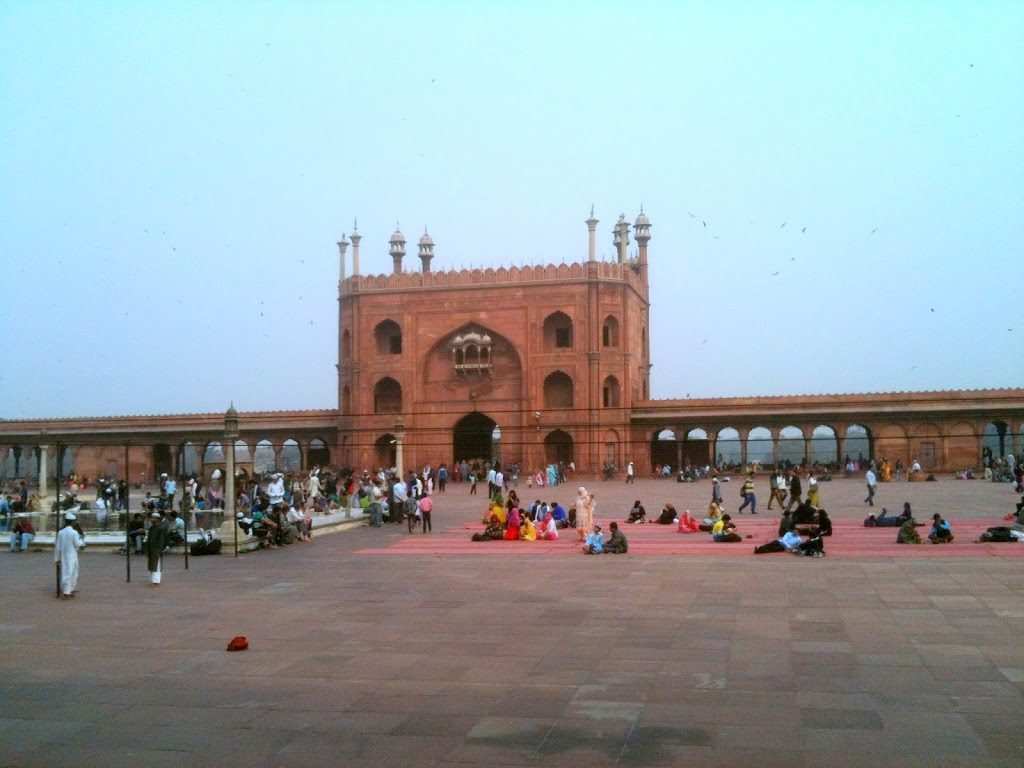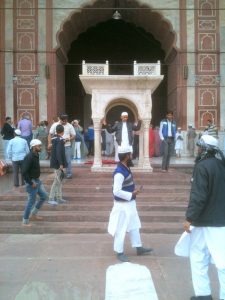
This long-awaited trip to India was to honour my Mother’s 80th birthday, and equally to fulfill a mutual curiosity for this fascinating country. Our inaugural trip, visiting the Indian states of Rajasthan and Uttar Pradesh, was rich with colourful experiences in every sense of the word … pungent fragrances, mouth-watering flavours, combined with incredible contrasts and whimsy… leaving me inspired, as well as touched by the gentility and generosity of the people we encountered at every level.
Our first stop was Delhi, a busy, bustling city shrouded in a hazy smog, like a perpetual dawn.
Everyone seemed to be in a hurry to get somewhere; the traffic appeared gridlocked, but the persistent horns and daring manoeuvres somehow managed to keep it flowing.
 The variety of vehicles was fascinating, and it seemed to be a challenge as to how heavy a load one could carry, albeit through necessity. Bicycle rickshaws were piled ridiculously high with enough cargo to fill a small truck; and old rusty scooters commonly served as the family car.
The variety of vehicles was fascinating, and it seemed to be a challenge as to how heavy a load one could carry, albeit through necessity. Bicycle rickshaws were piled ridiculously high with enough cargo to fill a small truck; and old rusty scooters commonly served as the family car.
The infrastructure was a mixture of old decaying buildings, alongside half-finished new construction. The latter provided work for those inhabited under bright blue tarpaulins, lining the roadsides like collapsed market stalls. This was clearly home for many, whose washing line was the central barrier dividing the dual carriageway, where dust and exhaust fumes sadly negated the efforts of laundering.
 ‘Sacred’ cows roamed through the slow-moving traffic, abandoned for their inutility, being either a male calf or an old milkless cow – both would probably die, either from starvation, dehydration or choke on the piles of rubbish they foraged.
‘Sacred’ cows roamed through the slow-moving traffic, abandoned for their inutility, being either a male calf or an old milkless cow – both would probably die, either from starvation, dehydration or choke on the piles of rubbish they foraged.
Our first historical site was the Qutb Minar complex, where we gazed up in admiration at the tallest brick minaret in the world, standing 73 metres high. I’m always astounded by the workmanship of such ancient buildings and monuments, curious to know exactly how the bricks or rocks were mounted to such great heights, in the absence of modern day technology all those years ago (825 to be precise).

The next stop was Mahatma Gandhi’s cremation site, Raj Ghat, which seemed to radiate a tranquil spiritual ambiance, with a simplicity that reflected the humility of this heroic pacifist.
An equally memorable, yet sharply contrasting experience was our bicycle rickshaw ride around Chandni Chowk in Old Delhi. Built in the 17th century, it is one of India’s oldest, as well as largest and busiest, wholesale markets.

The market’s narrow lanes were lined with tiny shop fronts and open kiosks selling everything from live hens in cages (ready to be selected and publicly beheaded) to gaudy religious paraphernalia and multicoloured saris, intricately brocaded.
We hung on tightly to our rickety rickshaw as it was deftly manoevred through a chaotic traffic of people, animals, scooters and overburdened market trolleys.
We saw shoes being shined with quasi antique equipment; and a smart barber shop, straight out of the last century, was equally doing a busy trade. Its pristine white tiles looked all the more sanitary, juxtaposed with the blackened disused car parts neatly stacked on the neighbouring stall.
This was all accompanied by a mixture of aromas – from urine to incense, including the aroma of sweet fried delicacies – and an orchestra of ubiquitous horns and rickshaw bells, together with cries of vendors and echoing calls to prayer from nearby minarets.
Feeling rather dazed and stimulated post-rickshaw, we soon found ourselves respectfully barefooted and shrouded in long robes, to visit the oldest and largest mosque in India – Jama Masjid, established by Shah Jahan in the 17th century.
The mosque’s red sandstone prayer hall, flanked by two towering minarets, with high cusped arches and marble domes, is orientated towards Mecca to the west. This is perfectly logical, given India’s geographical location, but my British/Western education still made me stop and think.

Its massive courtyard accommodates up to 25,000 worshippers, and the huge flights of stairs to each of its three grandiose gates provide additional kneeling space for the faithful during key Islamic festivals.

I was surprised to learn, and also witness, that the principal tourists in India are Indian nationals versus international tourists from abroad. It made our trip seem all the more authentic, reminiscent of a past gone era, when Western gentlemen and women overseas were a rare phenomenon.
After a wealth of new experiences in this bustling city, we were pleased to return to the peaceful surroundings of our boutique hotel, where we relaxed before enjoying a delicious ‘Thali’. This selection of subtly spiced dishes, with a host of exotic and fascinating ingredients, somewhat echoed my first impressions of this captivating Indian capital.













